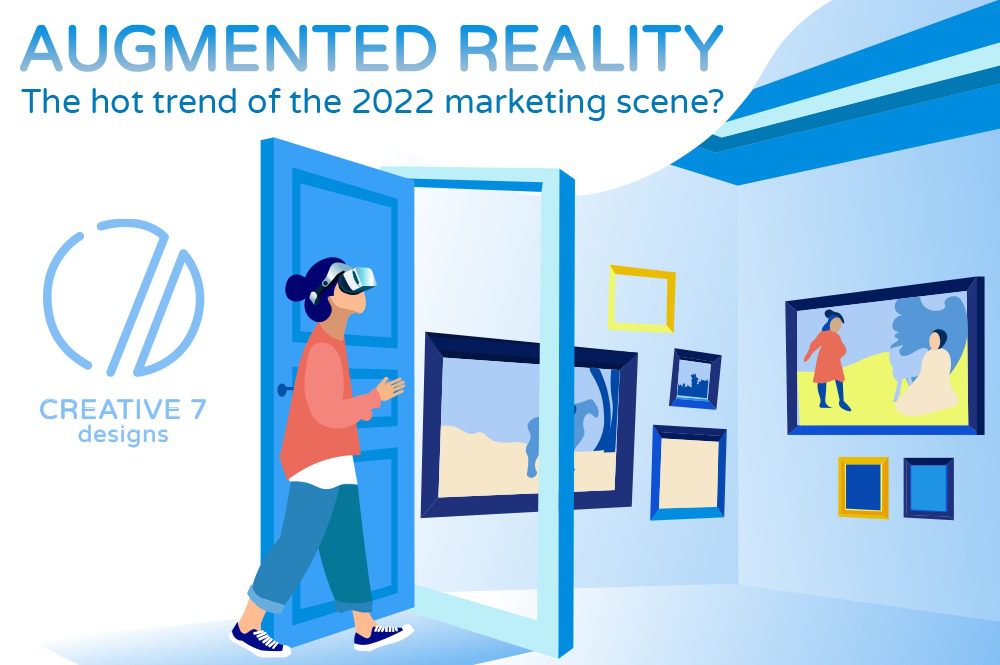THE HISTORY OF AUGMENTED REALITY:
The technology has come a long way with a growing list of use cases for AR. From NASA simulations to immersive marketing experiences, augmented reality makes tasks easier – and definitely more fun!
Over the last 50 years, augmented reality technology has reshaped the way we consume content in the real world. And now more than ever, as technology continues to advance, consumers are responding to AR-inspired experiences, causing companies to incorporate more augmented reality experiences into their marketing strategies.
As we mentioned at the beginning of this article, augmented reality has been around for years — as in AR tech dating back to as early as the 60s according to this article. Granted, in the early stages, augmented reality and virtual reality were essentially the same concept. But the two split eventually split advance from here.
Let’s take a brief look at the timeline of augmented reality from the 1960s to the turn of the century in 1999:
- 1968: Ivan Sutherland, a Harvard professor and computer scientist, created the first head-mounted display called ‘The Sword of Damocles’. The user experienced computer-generated graphics that enhanced their sensory perception of the world.
- 1974: Myron Kruger, a computer researcher and artist, built a laboratory at the University of Connecticut called ‘Videoplace’ that was entirely dedicated to artificial reality.
- 1990: Tom Caudell, a Boeing researcher, coined the term ‘augmented reality’.
- 1992: Louis Rosenburg, a researcher in the USAF Armstrong’s Research Lab, created ‘Virtual Fixtures’, which was one of the first fully functional augmented reality systems.
- 1994: Julie Martin, a writer and producer, brought augmented reality to the entertainment industry for the first time with the theater production titled Dancing in Cyberspace.
- 1998: Sportsvision broadcasts the first live NFL game with the virtual 1st & Ten graphic system – aka the yellow yard marker. The technology displays a yellow line overlayed on top of the feed to that views can quickly see where the team just advance to to get a first down.
- 1999: NASA created a hybrid synthetic vision system of their X-38 spacecraft. The system leveraged AR technology to assist in providing better navigation during their test flights.
BENEFITS OF AUGMENTED REALITY IN MARKETING:
“Augmented reality in marketing can be used as a brand differentiator to deliver lasting impressions. Those that are using AR successfully understand that it needs to provide value, and not just be a gimmick,” says The Fulfillment Labin their article on the benefits of augmented reality.
Since AR technology is still relatively young, gimmicks can work in the short-term, but it won’t be long before AR is considered a marketing mainstay and it’s novelty wears off. That’s when only those that use AR the right way will benefit.
2 SUCCESSFUL EXAMPLES OF MARKETERS UTILIZING AUGMENTED REALITY:
1. Augmented Reality for Product Marketing – Home Depot:
Back in 2015, Home Depot released their Project Color app. This app used patent technology to show users what a paint color will look like in their home.
Not only did the AR technology take lighting, objects, and shadows in the room into account, but Home Depot took it a step further two years later and let users check out how objects like patio furniture, faucets, and other products looked in their home.
Of course, Home Depot isn’t the only home furniture store to use AR to create value for their users (Lowe’s and Ikea have similar AR technology built into their apps).
2. AR and Experiential Marketing – Netflix:
Back when Snapchat was super cool, Netflix took advantage of the tech-forward social media platform when it was time to market season two of its original series Stranger Things.
The streaming company launched a series of AR/VR lenses on Snapchat that allowed users to record videos of themselves walking through one of the houses seen in the show, as monsters (Demigorgons) popped out of the wall.
“Aside from this lens, which is incredibly immersive for a mobile app, Netflix has also leveraged AR filters to promote its content,” the Hubspot Blog wrote.
WHAT WE CAN EXPECT FROM AUGMENTED REALITY:
Enabling Product Visualization:
“In a world where consumers order everything from clothes to cars online, marketers can harness AR to help shoppers visualize products in an interactive and immersive way that goes far beyond a static image or video. This could mean experiencing what it’s like to sit inside a dream car, watching AR panoramas unfold through the virtual windscreen, or seeing what a jacket looks like on the actual shopper, without them having to leave the house.” – MarTech Series
Future-proofing Education and Development:
One website states that classroom education can be extraordinary and more interactive with AR, as it enables teachers to show virtual examples of concepts and add gaming elements to provide textbook material support. Augmented Reality in the education sector renders several sought-after perks including:
- A Swift And Effective Learning System
- Easy Access To Learning Materials Anytime, Anywhere
- Immersive Practical Learning
- Engage Students And Spruce Up Their Interest
AR In Professional Training
And the learning benefits of AR also extend beyond the classroom. The same goes for professional training.
In mechanical fields especially, the technology can train people how to complete tasks by superimposing the end result on the version the trainee is practicing with.
Implementing AR in professional development cases has shown significant improvements to learning curves, creativity, and spatial awareness. (A study conducted by the National Training Laboratories found that “learning by doing” has shown to increase learning retention rates by up to 75% compared to simply listening to a seminar or lecture.
This article also talks about how augmented reality can affect industries like aerospace, aviation, hospitality, military, and others. Such industries have to invest a huge amount of money and equipment in military training. However, AR can reduce the expenses make training interactive.


